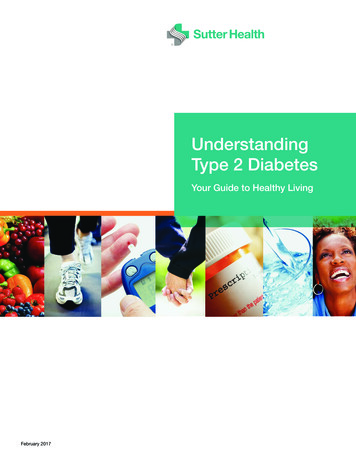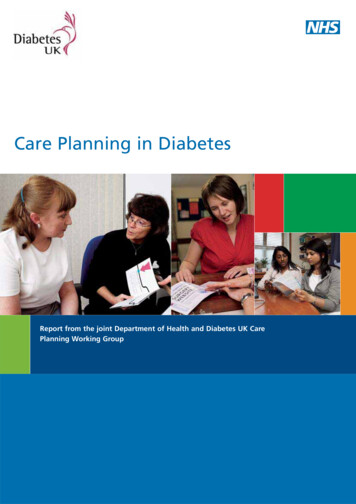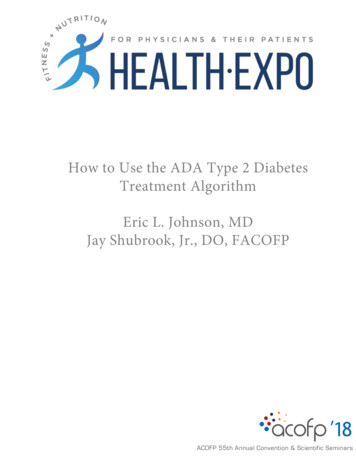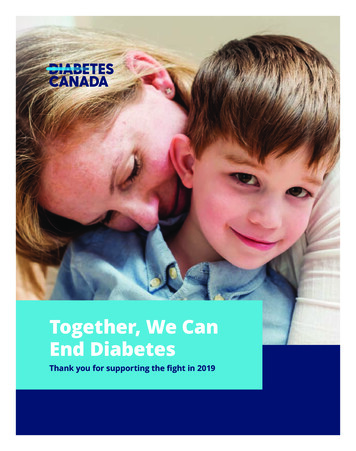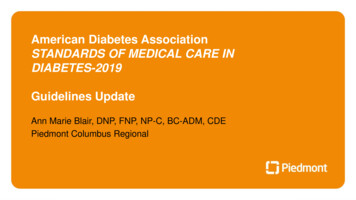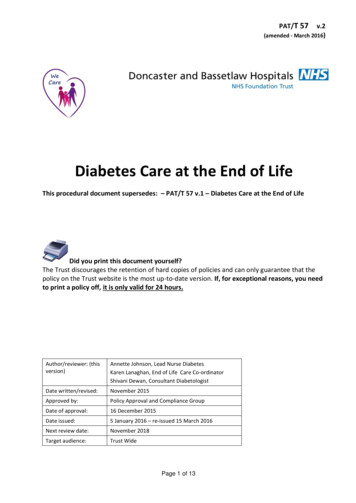
Transcription
PAT/T 57v.2(amended - March 2016)Diabetes Care at the End of LifeThis procedural document supersedes: – PAT/T 57 v.1 – Diabetes Care at the End of LifeDid you print this document yourself?The Trust discourages the retention of hard copies of policies and can only guarantee that thepolicy on the Trust website is the most up-to-date version. If, for exceptional reasons, you needto print a policy off, it is only valid for 24 hours.Author/reviewer: (thisversion)Annette Johnson, Lead Nurse DiabetesKaren Lanaghan, End of Life Care Co-ordinatorShivani Dewan, Consultant DiabetologistDate written/revised:November 2015Approved by:Policy Approval and Compliance GroupDate of approval:16 December 2015Date issued:5 January 2016 – re-issued 15 March 2016Next review date:November 2018Target audience:Trust WidePage 1 of 13
PAT/T 57v.2(amended - March 2016)Amendment FormPlease record brief details of the changes made alongside the next version number. If theprocedural document has been reviewed without change, this information will still need to berecorded although the version number will remain the same.VersionDate IssuedBrief Summary of ChangesAuthorVersion 2(amended)15 March 2016Addition to section 4.2 at the request of theEthics Advisory Committee – see Type 1diabetes: DO NOT DISCONTINUE THEINSULIN, unless the patient requests it to bestopped.Annette JohnsonVersion 25 January 2016 This document has been revised withsignificant changes - please read in fullAnnette JohnsonKaren LanaghanShivani DewanVersion 1June 2012 This is a new procedural document please read in fullLaura McTagueJohn HoskerTracy EvansPhillipsPage 2 of 13
PAT/T 57v.2(amended - March 3Duties and Responsibilities4Procedure54.1 Key Principles of Care54.2 Management Goals in Key Clinical Areas65Training/Support66Monitoring Compliance with the Procedural Document67Definitions68Equality Impact Assessment79Associated Trust Procedural Documents710References7Appendix 1Algorithm for End of Life Diabetes Care Management8Appendix 2Adult Diabetic Keto-acidosis (DKA) - IPOC 1421 WPR39420Appendix 3Equality Impact Assessment Form4Appendices:Page 3 of 139-1213
PAT/T 57v.2(amended - March 2016)1.INTRODUCTION1.1Approximately half a million people die in the United Kingdom each year, of whommore than three quarters are aged 75 years and over. Calculations based on theprevalence of diabetes indicate that 6-9% of those dying will have diabetes, the majoritywith Type 2 diabetes (Association of British Clinical Diabetologists (ABCD) - Statement2010. The National Diabetes Inpatient audit found that patients with diabetesaccounted for 15.8% of all hospital audited beds (NaDIA 2013).1.2Previous studies into the care of people with diabetes at the end of life have highlighteda wide variation in clinical practice. There has been no clear consensus or guidanceabout the frequency of blood sugar testing and the use of sliding scale insulin/complexinsulin regimes at the end of life.2.PURPOSEThe purpose of this document is to empower staff within DBHFT who liaise, interact, or havemanagement responsibilities for those patients (and their families/carers) with diabetes at theend of their life.The key points are: Describe a consistent high quality approach towards end of life diabetes care. Inform the workforce about the key issues in end of life diabetes care, providing a platformfor sensitive, appropriate and supportive care. To foster partnerships in end of life diabetes care within Trust established Palliative CarePlanning, the DBHFT Individualised Plan of Care in Last Hours/Days of Life (IPOC 029) andManagement of Patients who are End of Life (PAT/T 65).3.DUTIES AND RESPONSIBILITIESLead Nurse Diabetes and Endocrinology Implementation of this policy and all National recommendations made regardingdiabetes at the end of life care. Ensure education and training of all appropriate Trust staff. Responsibilities to ensure all patients with diabetes receive an equitable and high qualityservice. To be alerted to all patients with diabetes who are identified as being in the last fewdays/hours of life. Escalate any incidents regarding diabetes end of life care to the relevant clinicalgovernance groups.Lead Diabetologist and Specialist Palliative Care Consultant Act as a clinical expert in diabetes end of life care. Provide education and training to medical staff.Page 4 of 13
PAT/T 57v.2(amended - March 2016)Head of Nursing and Quality for Speciality Services Care Group Support the Lead Nurse in provision of care for patients with diabetes at the end of life. Doncaster Diabetes Network meeting meet every two months and may include End of LifeCare on the agenda.Matrons and Ward Managers To promote safe standards of diabetes end of life care on all wards as appropriate. Ward Managers to release staff when required in order to participate in education andtraining.All staff directly involved in caring for patients who are dying and have diabetes All staff to demonstrate empathy and good communication when dealing with patientsdeemed to be in the last few days/hours of life and also their relatives. Rememberingthat many of these patients will have self-managed their diabetes care for many yearsand may want to continue to make decisions. 4. To ensure all diabetic patients on the individualised plan of care for the last fewdays/hours of life, are referred to the Diabetes Specialist Nurse Team so that they canoffer the patient and staff full support and guidance.PROCEDUREEnd of life/Specialist Palliative Care Team referral to Diabetes Specialist Nursing Team toinform of patient. Outside working hours (i.e. Monday-Friday 8.30am – 5.00pm) a discussionregarding diabetes care should be with the Consultant team.Talk to the individual and their family to discuss the diabetes management during the lasthours/days of life.Explain to the patient/family the principles of diabetes care at the end of life.Document within the Individualised Plan of Care in Last Hours/Days of Life (IPOC 029)Multi-disciplinary Team progress notes an individualised medical plan for the patient.Agree this plan of care with the patient/relative and multi-disciplinary team caring for theindividual/End of Life Care Team.4.1Key Principles of Care Provision of a symptom free-death.Tailor glucose- lowering therapy and minimise diabetes - related adverse treatment.Avoid metabolic de-compensation and diabetes related emergencies: Frequent and unnecessary hypoglycaemia. See In Hospital Managementof Hypoglycaemia in Adults with Diabetes Mellitus – PAT/T 49. Diabetic keto-acidosis; if this occurs follow IPOC 1421 WPR39420 - seeAppendix 2; Hyperosmolar hyperglycaemic state; Persistent symptomatic hyperglycaemia.Avoidance of symptomatic clinical dehydration.Page 5 of 13
PAT/T 57 4.2Management goals in key clinical areas 5.v.2(amended - March 2016)Support and maintain the empowerment of the individual patient (in their diabetesmanagement) and their carer to the last possible stage.Glucose control targets - Discuss with the patient and responsible MDT therecommendation that blood glucose should not be maintained lower than 6mmol/l orhigher than 15mmol/l to avoid symptoms.Prevention/ management of hypoglycaemiaAdjustment of hypoglycaemic agents as below. Follow the Trust protocol for In HospitalManagement of Hypoglycaemia in Adults with Diabetes Mellitus - PAT/T 49.Type 1 diabetes: Insulin withdrawal is likely to lead to death. Insulin therapy should besimplified. DO NOT DISCONTINUE THE INSULIN, unless the patient requests it to bestopped. - See Appendix 1.Type 2 diabetes on Insulin therapy: Insulin therapy should be simplified. See Appendix1.Type 2 diabetes treated with diet/diet and tablets/non- insulin injectableStop hypoglycaemic agents. Stop blood glucose monitoring. If patient symptomatic ofhyperglycaemia e.g. polyuria or polydipsia check blood glucose with point of care testingequipment.a) If blood glucose less than 15mmol/l only retest if symptoms are troublesome.b) If blood glucose greater than 15mmol/l consider long acting analogue insulin.c) See Appendix 1 for guidance.TRAINING/SUPPORTThe Trust training needs analysis (diabetes) will identify individual needs for staff.Diabetes and Endocrinology can be contacted at any time for support.6.MONITORING COMPLIANCE WITH THE PROCEDURAL DOCUMENTWhat is being MonitoredWho will carry outthe MonitoringEnd of Life Care in patientswith the co-morbidity ofDiabetes who have beenreferred to the DiabetesSpecialist Nurse TeamIn-patient DiabetesSpecialist NurseTeam (IDSN)7.How oftenAnnuallyDEFINITIONSIDSN - In-patient diabetes specialist nurseABCD – Association of British Clinical DiabetologistsPage 6 of 13How Reviewed/Where Reported toA review of blood glucosecontrol will take place withintwo weeks of death and anannual audit will be presentedby the Lead Nurse Diabetes &Endocrinology at PSRG/End ofLife Care Team Meeting.
PAT/T 57v.2(amended - March 2016)8.EQUALITY IMPACT ASSESSMENTAn Equality Impact Assessment (EIA) has been conducted on this procedural document in linewith the principles of the Equality Analysis Policy (CORP/EMP 27) and the Fair Treatment for AllPolicy (CORP/EMP 4).The purpose of the EIA is to minimise and if possible remove any disproportionate impact onemployees on the grounds of race, sex, disability, age, sexual orientation or religious belief. Nodetriment was identified (see Appendix 3).9. ASSOCIATED TRUST PROCEDURAL DOCUMENTSMental Capacity Act 2005 - Policy and Guidance, including Deprivation of Liberty Safeguards(DoLS) - PAT/PA 19Privacy and Dignity - PAT/PA 28In Hospital Management of Hypoglycaemia in Adults with Diabetes Mellitus – PAT/T 49Management of Patients who are End of Life – PAT/T 65Individualised plan of care in last hours/days of life – IPOC 029 WPR2388710.REFERENCESABCD 2010, Position statement on diabetes and end of life care (Association of British ClinicalDiabetologists)DIABETES UK (2013) End of Life Diabetes Care: Clinical Care Recommendations 2nd edition onwww.diabetes.org.ukHSCIC (2013) National Diabetes In-patient audit 2013 rch?q nadia&area both.Page 7 of 13
PAT/T 57v.2(amended - March 2016)APPENDIX 1 - ALGORITHM FOR END OF LIFE DIABETES CARE MANAGEMENT(To be followed when the patient is on the Individualised Plan of care in Last Hours /Days of Life)All discussions and management plan to be documen ted in the IPOC Refer to the In-patient Diabetes Specialist Nurse TeamType 2 DiabetesDiet control orMetformin treatedStop metformin ifprescribed andstop bloodglucosemonitoringType 2 DiabetesOther hypoglycaemicagents and GLP1Agonist e.g.Liraglutide/ExenatideStop tablets andGLP1 injectionStop blood glucosemonitoringIf symptomatic ofpolyuria/polydipsiaCheck blood glucoseIf greater than20mmols consideradding in dailyinsulin injection e.g.Lantus/LevemirPage6 8 of 13unitsIf insulin is requiredType 2 DiabetesInsulin therapy withor without oralagentsStop oral therapyChange insulin to a dailylong acting insulin with a25% reduction onprevious dosee.g. Lantus or LevemirType 1 DiabetesContinue BasalInsulin e.g.Lantus/Levemirwith 20%reductionCheck blood glucose once daily at teatimeIf below 6mmol/l decrease insulin dose 20%If above 15mmol/l increase 10% to reduce risk ofsymptoms or ketosis
PAT/T 57v.2(amended - March 2016)APPENDIX 2 - IPOC 1421 WPR39420Page 9 of 13
PAT/T 57v.2(amended - March 2016)Page 10 of 13
PAT/T 57v.2(amended - March 2016)Page 11 of 13
PAT/T 57v.2(amended - March 2016)Page 12 of 13
PAT/T 57v.2(amended - March 2016)APPENDIX 3 - EQUALITY IMPACT ASSESSMENT PART 1 INITIAL iabetes & EndocrinologyCSU/Executive Directorate andDepartmentSpeciality Services Care GroupAssessor (s)Annette Johnson, Lead NurseNew or Existing ServiceDate of Assessmentor Policy?Existing policy revised10/11/20151) Who is responsible for this policy? Name of CSU/Directorate Speciality Services Care Group2) Describe the purpose of the service / function / policy / project/ strategy? To ensure all patients with Diabetes who reach the end of their life receive careensuring the control of their diabetes does not become a cause of death.3) Are there any associated objectives? Legislation, targets national expectation, standards No4) What factors contribute or detract from achieving intended outcomes? – Nil5) Does the policy have an impact in terms of age, race, disability, gender, gender reassignment, sexual orientation, marriage/civil partnership,maternity/pregnancy and religion/belief? Details: [see Equality Impact Assessment Guidance] - No If yes, please describe current or planned activities to address the impact [e.g. Monitoring, consultation] –6) Is there any scope for new measures which would promote equality? [any actions to be taken] No7) Are any of the following groups adversely affected by the policy? NOProtected CharacteristicsAffected?Impacta) AgeNob) DisabilityNoc) GenderNod) Gender ReassignmentNoe) Marriage/Civil PartnershipNof) Maternity/PregnancyNog) RaceNoh) Religion/BeliefNoi) Sexual OrientationNo8) Provide the Equality Rating of the service / function /policy / project / strategy – tick outcome boxOutcome 1 Outcome 2Outcome 3Outcome 4*If you have rated the policy as having an outcome of 2, 3 or 4, it is necessary to carry out a detailed assessment and complete a Detailed Equality Analysis form in Appendix 4Date for next review:Checked by:November 2018Annette JohnsonDate: 10/11/2015Page 13 of 13
Support the Lead Nurse in provision of care for patients with diabetes at the end of life. Doncaster Diabetes Network meeting meet every two months and may include End of Life Care on the agenda. Matrons and Ward Managers To promote safe standards of diabet



